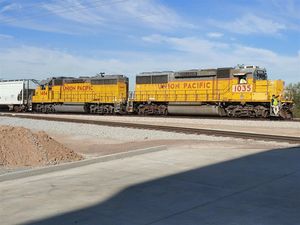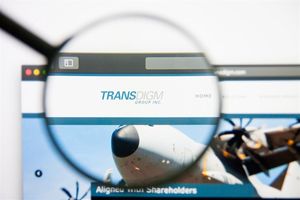Financial News
UAA Q1 Earnings Call: Under Armour Discusses Brand Reset Amid Revenue Decline and Strategic Shifts

Athletic apparel company Under Armour (NYSE: UAA) missed Wall Street’s revenue expectations in Q1 CY2025, with sales falling 11.4% year on year to $1.18 billion. Its non-GAAP loss of $0.08 per share was in line with analysts’ consensus estimates.
Is now the time to buy UAA? Find out in our full research report (it’s free).
Under Armour (UAA) Q1 CY2025 Highlights:
- Revenue: $1.18 billion (11.4% year-on-year decline)
- Adjusted EPS: -$0.08 vs analyst estimates of -$0.08 (in line)
- Revenue Guidance for Q2 CY2025 is $1.13 billion at the midpoint, below analyst estimates of $1.17 billion
- Adjusted EPS guidance for Q2 CY2025 is $0.02 at the midpoint, above analyst estimates of $0
- Operating Margin: -6.1%, down from -0.3% in the same quarter last year
- Locations: 441 at quarter end, up from 440 in the same quarter last year
- Constant Currency Revenue fell 9.8% year on year (-4.9% in the same quarter last year)
- Market Capitalization: $2.71 billion
StockStory’s Take
Under Armour’s first quarter results reflected the company’s efforts to reposition its brand and improve the quality of its revenue, as discussed by CEO Kevin Plank and CFO Dave Bergman. Management attributed the year-over-year sales decline to lower direct-to-consumer (DTC) volumes, especially in e-commerce, and reduced wholesale activity. Plank explained that strategic decisions to limit discounting and streamline product offerings were intended to protect brand equity, even as these actions pressured top-line results. Additionally, ongoing supply chain management and SKU reductions have been central to Under Armour’s plan to create a more focused and premium product mix. Plank acknowledged, “While we’re never satisfied with declining revenue, our fourth quarter results allowed us to exceed our fiscal ’25 outlook, demonstrating some of the foundational traction we’re gaining as we reposition the Under Armour brand.”
Looking forward, Under Armour’s guidance reflects continued caution as the company navigates a dynamic retail environment and the impact of evolving trade policy. Management emphasized the importance of maintaining gross margin improvements through premiumization, disciplined inventory management, and a shift toward higher-priced, differentiated products. Plank highlighted the upcoming launch of the UA Halo collection and a renewed focus on compelling storytelling and influencer partnerships to drive consumer engagement. CFO Dave Bergman stated that while the company is limiting its outlook to the next quarter due to tariff uncertainties, efforts to diversify sourcing and manage SG&A expenses remain priorities. The leadership team stressed that executing on product innovation, targeted marketing, and operational efficiency will be key to stabilizing performance and positioning Under Armour for future growth.
Key Insights from Management’s Remarks
Management attributed the quarter’s results to deliberate reductions in promotions, ongoing operational streamlining, and the impact of external trade and market pressures. The leadership team highlighted several strategic actions shaping both current performance and long-term brand positioning.
-
E-commerce and DTC Reset: Under Armour’s decision to reduce discounting and focus on full-price sales in its DTC channels led to lower e-commerce revenue but improved average unit retail and a healthier brand profile. Plank noted, “Our full price sales mix on our website [was] up double-digits year-over-year with promo and clearance down.”
-
SKU Rationalization and Premiumization: The company accelerated efforts to streamline its product assortment, removing lower-value activities and reducing SKUs to concentrate on premium, higher-margin categories. Plank described this as “selling so much more of so much less at a much higher full price.”
-
Category Management Model: A transition to category-led operating structures, with dedicated teams responsible for core areas such as training, running, and sportswear, was implemented to improve execution, speed, and regional relevance.
-
International Market Performance: EMEA outperformed other regions due to strong leadership and strategic category focus, while APAC continued to face challenges from a highly promotional environment and ongoing business resets. Plank noted, “We’re maintaining the discipline to protect the brand strength we’ve built [in EMEA].”
-
Supply Chain and Cost Management: Efforts to optimize the supply chain, including diversifying sourcing and driving cost efficiencies, contributed to gross margin gains. Bergman stated that supply chain benefits and pricing discipline were key factors, though he cautioned that these benefits may moderate in future quarters.
Drivers of Future Performance
Under Armour’s near-term outlook is shaped by ongoing brand repositioning, operational discipline, and uncertainty from recent tariff changes, which management expects will influence both revenue and profitability.
-
Sourcing Diversification and Tariff Mitigation: Management is proactively evaluating strategies to offset the impact of new tariffs, including diversifying sourcing away from affected regions, cost-sharing initiatives with partners, and targeted price adjustments. Bergman emphasized the company’s balanced sourcing footprint, with roughly 30% from Vietnam, 20% from Jordan, and the rest spread across other countries.
-
Product Innovation and Storytelling: The upcoming UA Halo collection, enhanced influencer partnerships, and a renewed focus on storytelling are intended to differentiate the brand and support premium pricing. Plank highlighted that “comprehensive go-to-market strategy that inspires consumers to want to buy UA at premium price points” will be central to the next phase.
-
SG&A and Cost Controls: The company plans to maintain tight control over SG&A, concentrating investments on high-impact initiatives while reducing discretionary spending and third-party costs. Bergman stated that planned restructuring and operational efficiencies are expected to deliver meaningful cost savings, though caution remains around cutting too deeply in areas critical for future growth.
Catalysts in Upcoming Quarters
In the coming quarters, our analysts will be watching (1) whether Under Armour can sustain gross margin improvements as promotional discipline continues, (2) evidence of renewed growth in North America as the brand reset matures, and (3) the reception of key product launches like UA Halo and their impact on consumer engagement. The evolving tariff environment and progress in international markets will also be critical to track.
Under Armour currently trades at a forward P/E ratio of 18.7×. Is the company at an inflection point that warrants a buy or sell? See for yourself in our full research report (it’s free).
Our Favorite Stocks Right Now
The market surged in 2024 and reached record highs after Donald Trump’s presidential victory in November, but questions about new economic policies are adding much uncertainty for 2025.
While the crowd speculates what might happen next, we’re homing in on the companies that can succeed regardless of the political or macroeconomic environment. Put yourself in the driver’s seat and build a durable portfolio by checking out our Top 5 Growth Stocks for this month. This is a curated list of our High Quality stocks that have generated a market-beating return of 183% over the last five years (as of March 31st 2025).
Stocks that made our list in 2020 include now familiar names such as Nvidia (+1,545% between March 2020 and March 2025) as well as under-the-radar businesses like the once-small-cap company Comfort Systems (+782% five-year return). Find your next big winner with StockStory today.
More News
View More





Quotes delayed at least 20 minutes.
By accessing this page, you agree to the following
Privacy Policy and Terms Of Service.



